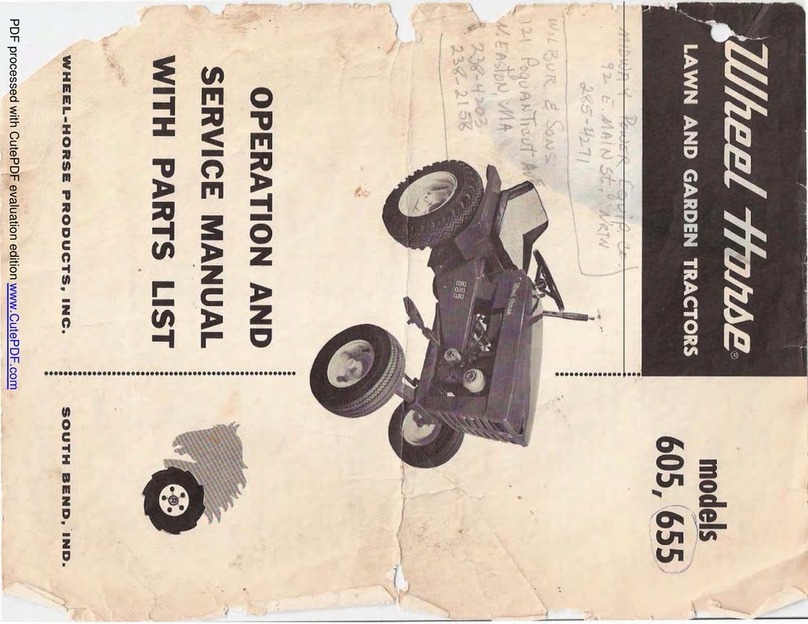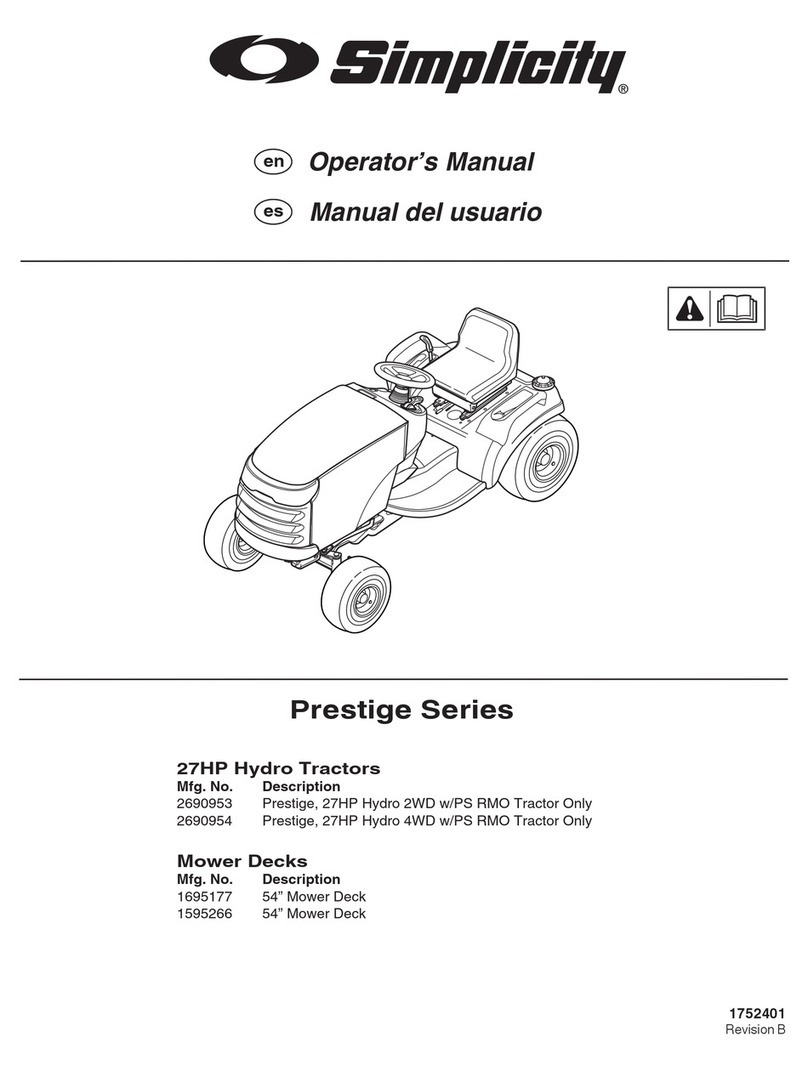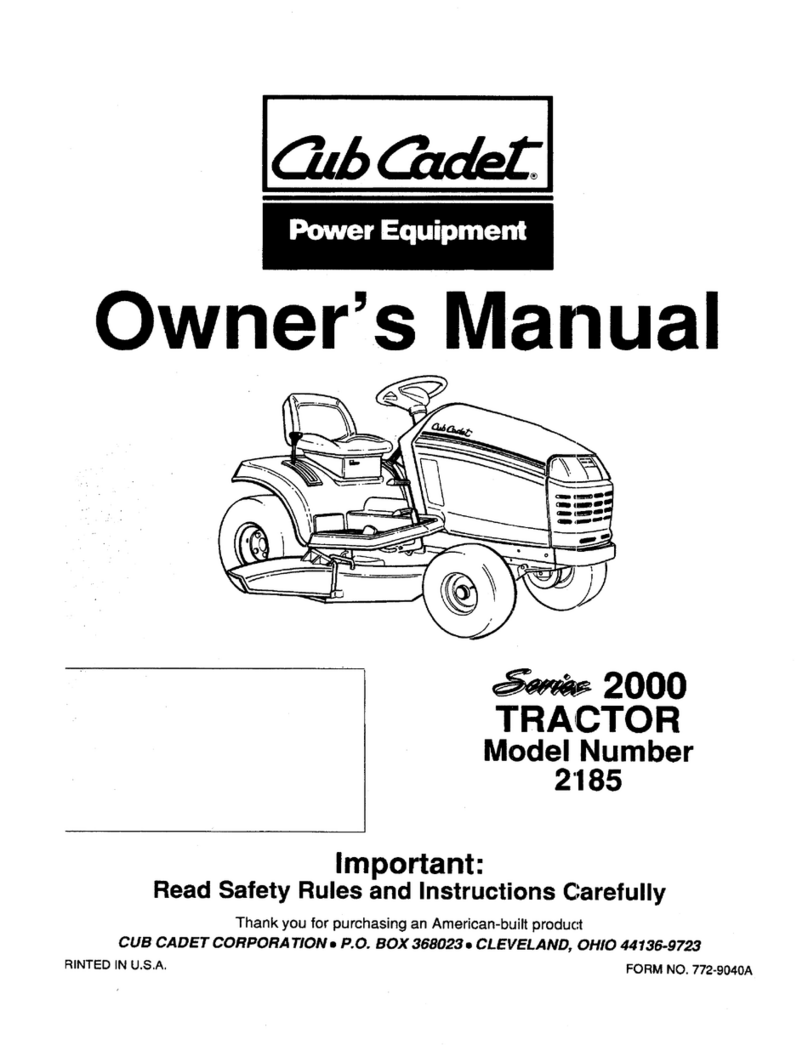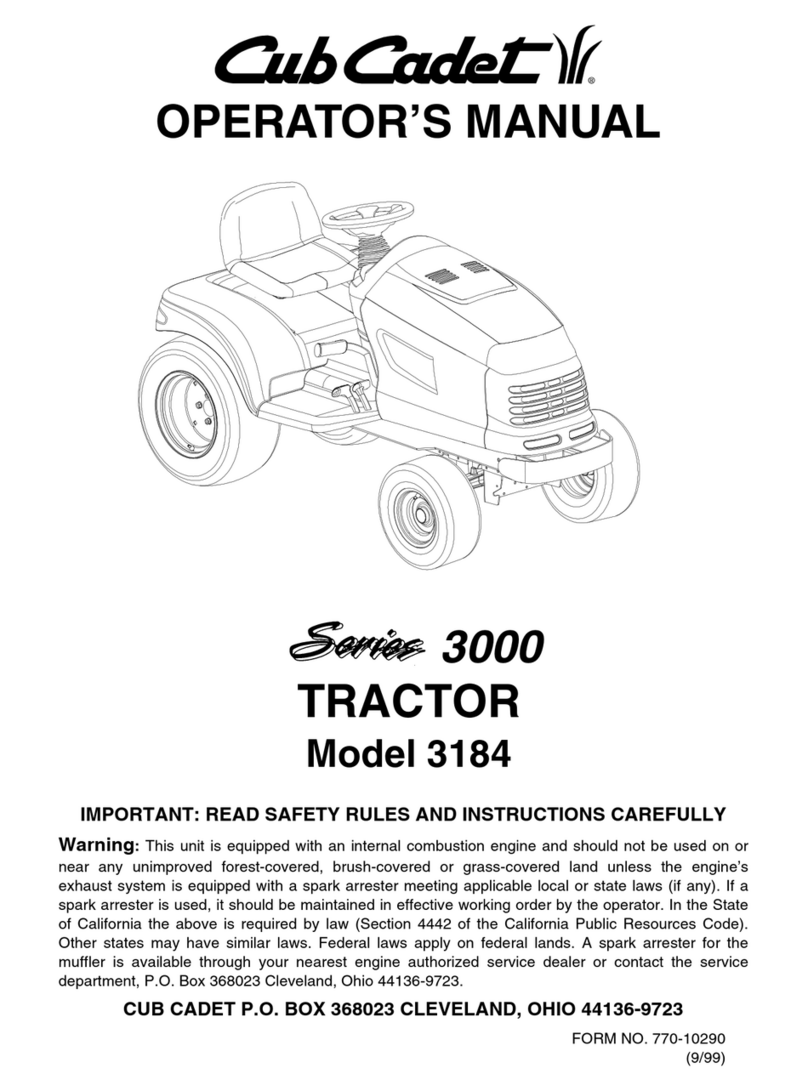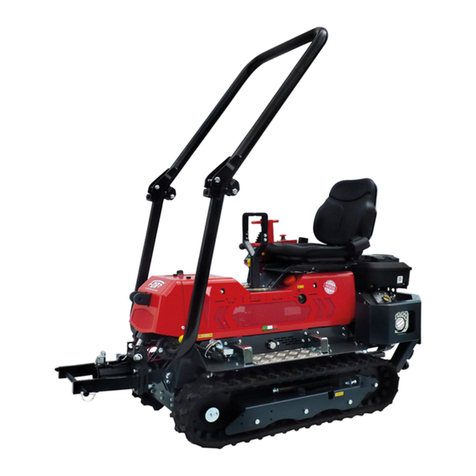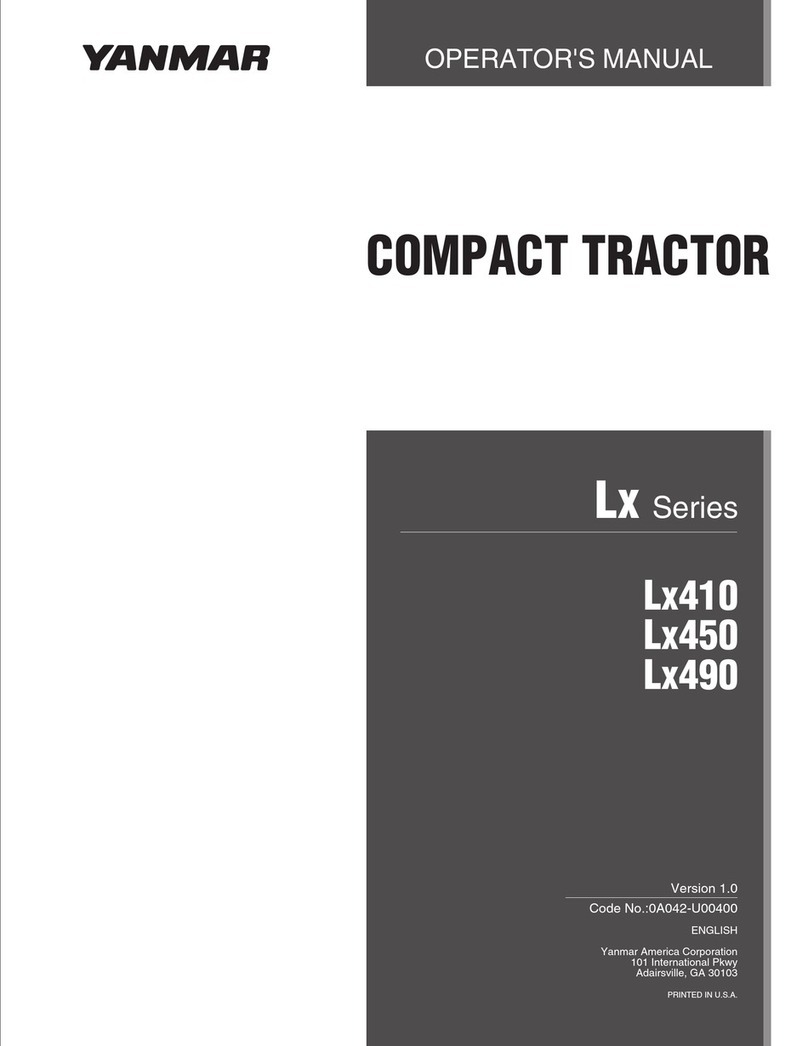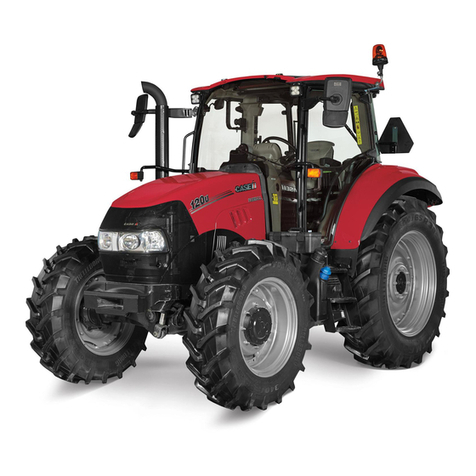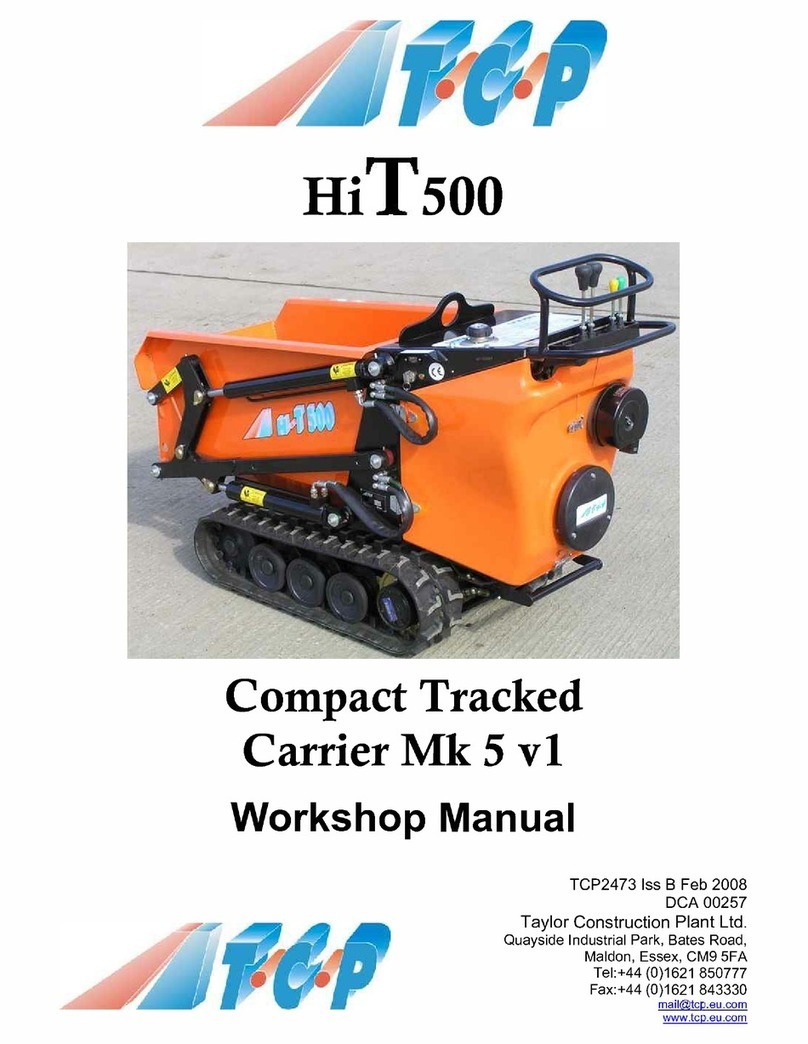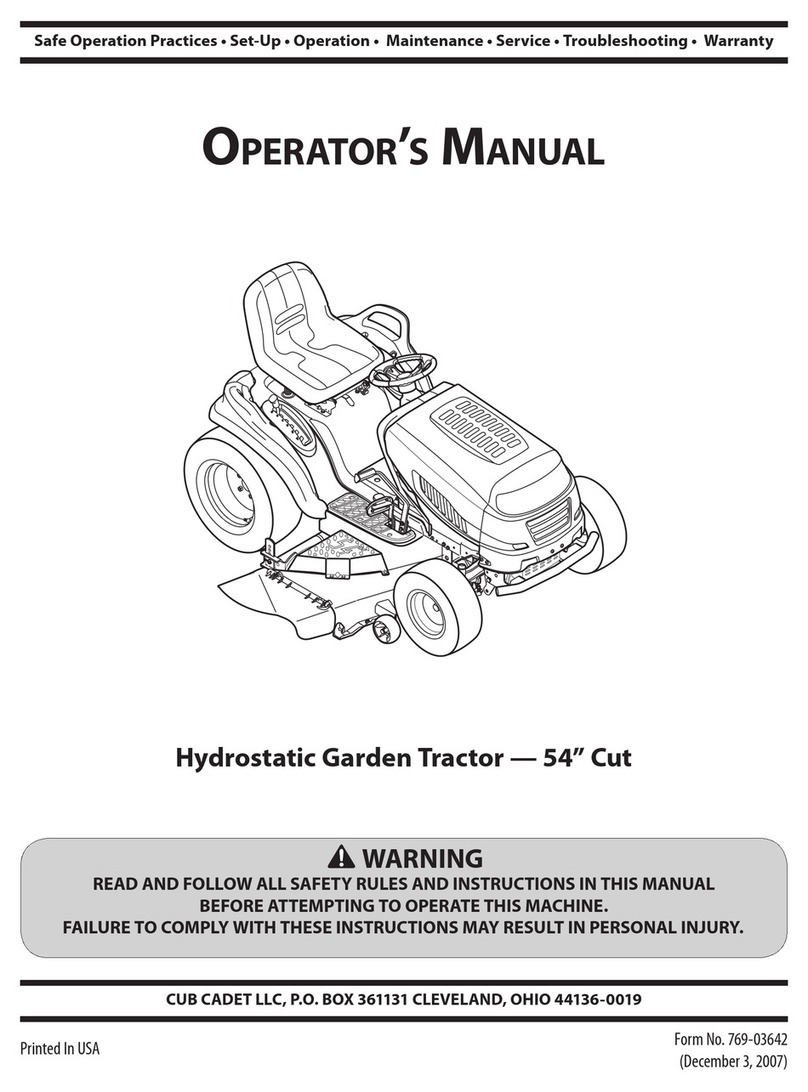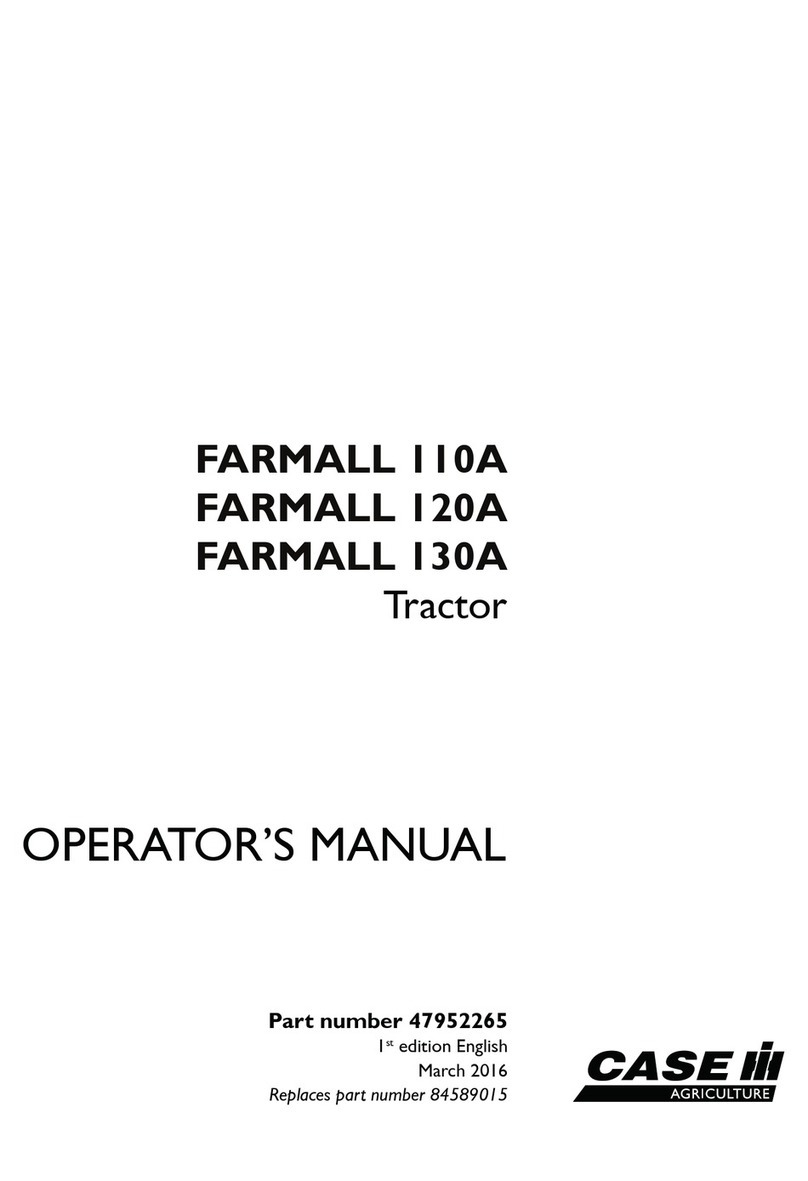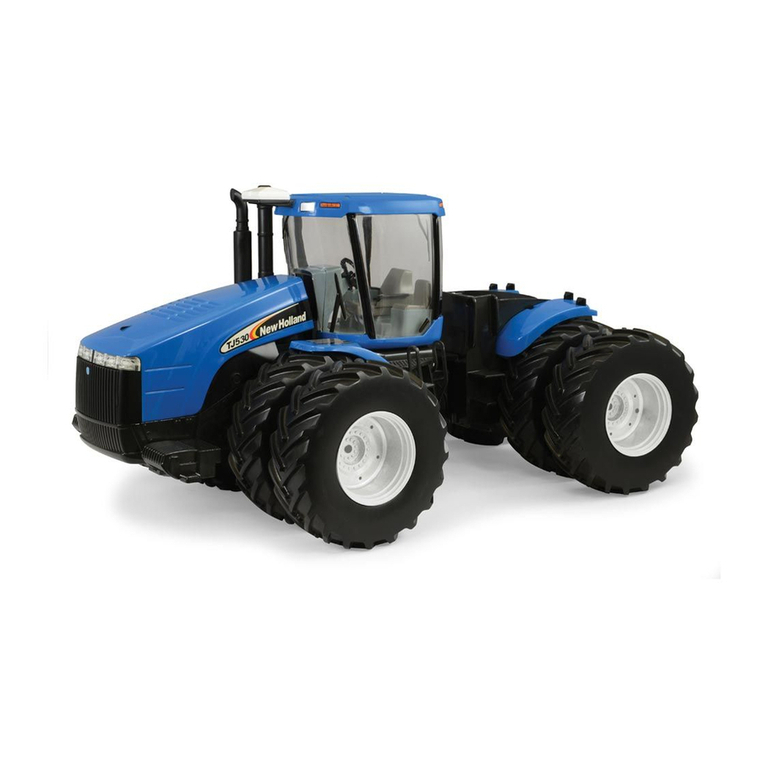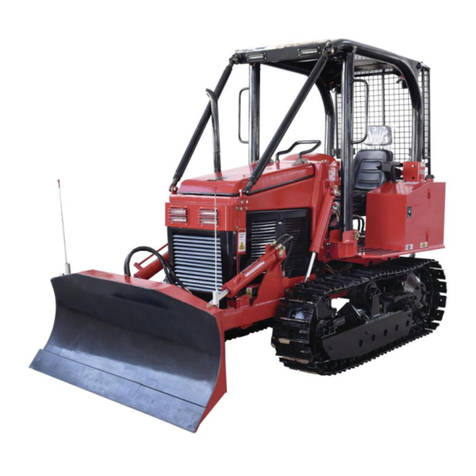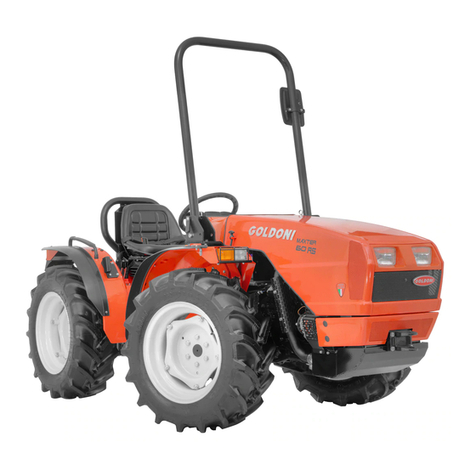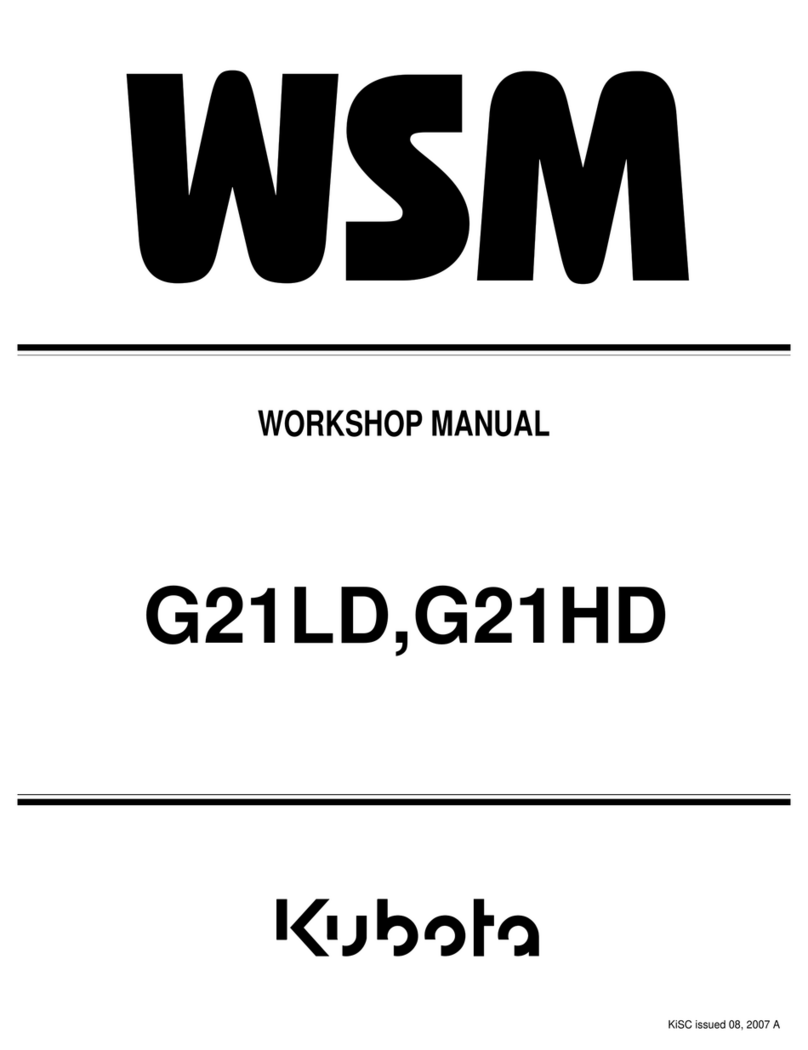Textron Steiner 430 MAX Owner's manual

Owner / Operator's Manual
Form # 09-367
430
MAX
4 - WHEEL DRIVE TRACTOR
Starting Serial No. 7001
CAUTION
Avoid injuries. Read and understand Operator’s manual
before operating tractor or equipment.
It contains instructions for safe operation.
Use this manual for 75-70004 25hp Kohler 430

Date of Purchase: Month ________________Day____________________Year _______________
Dealer Name _________________________Phone__________________
Serial Number ________________________
Model Number ________________________
ALWAYS GIVE MODEL AND SERIAL NUMBER WHEN ORDERING SERVICE PARTS
• READ AND UNDERSTAND OPERATORS MANUAL
BEFORE OPERATING OR SERVICING.
• OBEY ALL SAFETY INSTRUCTIONS. FAILURE TO DO SO
MAY RESULT IN INJURY TO YOU OR OTHERS.
• BE SURE MACHINE IS IN SAFE OPERATING CONDITION
BEFORE USE.
• INSPECT MACHINE DAILY. REPLACE ALL WORN OR
DAMAGED PARTS.
• KEEP ALL GUARDS AND SHIELDS IN PLACE.
• CHECK OPERATION OF ALL SAFETY INTERLOCK
SWITCHES DAILY.
• DO NOT OVERRIDE INTERLOCK SYSTEM, IT IS FOR YOUR
PROTECTION.
• DO NOT ALLOW MINORS OR THE INEXPERIENCED TO
OPERATE MACHINE.
• KEEP PEOPLE AND PETS A SAFE DISTANCE AWAY FROM
MACHINE USING POWER DRIVEN ATTACHMENTS.
INJURY COULD RESULT FROM FLYING DEBRIS.
CAUTION
STEINER TURF EQUIPMENT, INC.
289 N. Kurzen Rd., P.O. Box 504
Dalton, Ohio 44618
Telephone: (330) 828-0200
FAX: (330) 828-1008

TABLE OF CONTENTS
INTRODUCTION SECTION 1 Page
Introduction................................................................................................1-1
Specifications ............................................................................................1-2
SAFETY SECTION 2
General Safety ...........................................................................................2-1
Safety Practices and Training....................................................................2-2
Safety Decals.............................................................................................2-4
PRE-START INSTRUCTIONS SECTION 3
Starting Instructions...................................................................................3-1
Fuels and Oils............................................................................................3-2
OPERATION SECTION 4
Controls .....................................................................................................4-1
Operating Precautions...............................................................................4-4
Operating Instructions ...............................................................................4-4
SERVICE SECTION 5
Service Schedule.......................................................................................5-1
Capacities ..................................................................................................5-2
Engine........................................................................................................5-3
Hydraulic System ......................................................................................5-5
Adjustments...............................................................................................5-7
PTO and Belts............................................................................................5-9
Belt Chart ...................................................................................................5-10
Trouble Shooting Chart .............................................................................5-11
Emergency Moving ...................................................................................5-12
ASSEMBLY SECTION 7
Assembly Instructions ...............................................................................7-1
Warranty..........................................................................................last page
Form #09-367 rev 12/00

rev 12/98 1 - 1 09-367
INTRODUCTION section 1
Description
The Steiner 430 MAX is designed for the commercial user or homeowner. From the rugged industrial frame to
the operator controls... the tractor is ready for demanding turf and grounds care assignments.
Power steering and articulated frame, combined with a low center of gravity and high flotation tires, provide
exceptional maneuverability.
Fully hydrostatic, single lever control lets you choose infinite ground travel speeds to match the task. No
clutching, jerking or braking, just smooth power flow to the 4 full time drive wheels for added traction in tough
areas.
Front mounted attachments offer a wide range of working tools and all of them attach to the “Quick Hitch” that
is a Steiner exclusive. The front hitch is standardized for all models of Steiner power units so your present
attachments are not obsolete.
You can do many tasks with this one tractor, compared to higher priced single purpose machines, by simply
changing attachments in less than 2 minutes.
Operator safety and comfort, power, performance and dependability will provide years of enjoyment with your
Steiner tractor.

09-367 1 - 2 rev 12/00
INTRODUCTION section 1
SPECIFICATIONS
Dimensions:
Overall Width ______44"
Overall Length _____64"
Overall Height _____49"
Wheelbase _______38"
Inside Turning Radius _ _ 46"
Weight (Linamar) ____1000 lbs.
Weight (Kohler) _____1000 lbs.
Weight (Kubota) _____1100 lbs.
Engine:
Standard________Linamar LX790
20 HP air-cooled
Optional ________Kubota D722-E Diesel 44 cu. In. (719 cc )
liquid-cooled 21 HP @3600 RPM
Optional ________Kubota WG750-E Gas 45 cu. In. (740 cc )
liquid-cooled 21 HP
Optional ________Kohler Command V-Twin
25 HP air-cooled
Drive Train:
Transmission ______Sundstrand Hydrostatic
Series 15 Pump and
2 motors
Transaxles _______Peerless 2500 Series
2-speed
SPEEDS:
Forward (Traction Type Tires) _______0-8.5 MPH (high range)
0-4.4 MPH (low range)
Reverse (Traction Type Tires) _______0-5.3 MPH (high range)
0-2.8 MPH (low range)
Steering ________Hydraulic
power steering
Parking Brake______Disc type
Tires:
Traction Type ______21x11.00-8, Rawhide
Turf Type, optional ____20x10.00-8, Turfmate
Electrical:
Starting ________12volt, Key switch
Battery_________12volt, Group 26
Fuel System:
Tank capacity ______6Gallons
FuelPump_______Diaphragm (Linamar)
Diaphragm (Kohler)
Electric (Kubota)
Specifications are subject to change without notice.

rev 11/00 2 - 1 09-367
SAFETY section 2
SIGNAL WORD DEFINITIONS
Indicates an imminently hazardous situation
which, if not avoided, will result in death or
serious injury. This signal word is limited to the
most extreme cases.
Indicates a potentially hazardous situation
which, if not avoided, could result in death or
serious injury.
Indicates a potentially hazardous situation
which, if not avoided, may result in minor or
moderate injury and/or property damage. It may
also be used to alert against unsafe practices.
ATTENTION:
This symbol identifies potential health and
safety hazards. It marks safety precautions. Your
safety and the safety of others is involved.
BE ALERT!
WARNING
The engine exhaust from this product
contains chemicals known to the State of
California to cause cancer, birth defects or
other reproductive harm.
CALIFORNIA
Proposition 65 Warning
Diesel engine exhaust and some of its
constituents are known to the State of
California to cause cancer, birth defects and
other reproductive harm.
CALIFORNIA PROPOSITION 65
Battery Warning
Battery posts, terminals and related
accessories contain lead and lead
compounds, chemicals known to the State of
California to cause cancer and reproductive
harm.
WASH HANDS AFTER HANDLING!

IMPORTANT
Safety Practices For Commercial
Turf Care Equipment
I Training
1. Read the Operator’s manual and other training
material. If the operator(s) or mechanic(s) can not
read English it is the owner’s responsibility to
explain this manual to them.
2. Become familiar with the safe operation of the
equipment, operator controls, and safety signs.
3. All operators and mechanics should be trained. The
owner is responsible for training the users.
4. Never let children or untrained people operate or
service the equipment. Local regulations may
restrict the age of the operator.
5. The owner/user can prevent and is responsible for
accidents or injuries occurring to themselves,
other people, or property.
II Preparation
1. Evaluate the terrain to determine what accessories
and attachments are needed to properly and
safely perform the job. Only use accessories and
attachments approved by the manufacturer.
2. Wear appropriate clothing including hard hat, safety
glasses, and ear protection. Long hair, loose
clothing, or jewelry may get tangled in moving
parts.
3. Inspect the area where the equipment is to be used
and remove all objects such as rocks, toys, and
wire which can be thrown by the machine.
4. Use extra care when handling gasoline and other
fuels. They are flammable and the vapors are
explosive.
a. Use only an approved container.
b. Never remove gas cap or add fuel with engine
running. Allow engine to cool before refueling.
Do not smoke.
c. Never refuel or drain the machine indoors.
5. Check that operator’s presence controls, safety
switches, and shields are attached and functioning
properly.
III Operation
Slopes are a major factor related to
loss-of-control and tip-over accidents, which can
result in severe injury or death. All slopes
require extra caution.
1. Never run an engine in an enclosed area.
2. Only operate in good light, keeping away from holes
and hidden hazards.
3. Be sure F-R lever is in neutral, PTO is off, and
parking brake is engaged before starting engine.
Operate all controls from the operator’s seat. Use
seat belts if provided.
4. Slow down and use extra care on hillsides. Be sure
to travel in the recommended directions on
hillsides. Turf conditions can affect the machines
stability. Use caution when operating near
drop-offs.
5. Follow the manufacturers recommendations for
wheel weights or counterweights to improve
stability. (See Section 4, page 4-4; also the
owner's manual for the attachment being used.)
6. Slow down and use caution when making turns and
when changing directions on slopes.
7. Never raise mower deck with the blades running.
8. Never operate with guards not securely in place. Be
sure all interlocks are attached, adjusted properly,
and functioning properly.
9. Never operate mower with the discharge deflector
raised, removed or altered, unless using a grass
catcher.
10. Do not change the engine governor setting or
overspeed the engine.
11. Never leave a running machine unattended.
09-367 2 - 2 rev 12/98
SAFETY section 2

12. Stop on level ground, lower implements,
disengage drives, engage parking brake, and shut
off engine before leaving the operator’s position for
any reason including emptying the catchers or
unclogging the chute.
13. Stop equipment and inspect blades after striking
objects or if an abnormal vibration occurs. Make
necessary repairs before resuming operations.
14. Keep hands and feet away from cutting units.
15. Look behind and down before backing up to be
sure of a clear path.
16. NO RIDERS. Never carry passengers and keep
pets and bystanders away.
17. Slow down and use caution when making turns
and crossing roads and sidewalks. Stop blades if
not mowing.
18. Be aware of the mower discharge direction and do
not point it at anyone.
19. Do not operate the machine under the influence of
alcohol or drugs.
20. Use care when loading or unloading the machine
into a trailer or truck.
21. Use care when approaching blind corners, shrubs,
trees, or other objects that may obscure vision.
IV Maintenance and storage
1. Disengage drives, lower implement, set parking
brake, stop engine and remove key or disconnect
spark plug wire. Wait for all movement to stop
before adjusting, cleaning, or repairing.
2. Clean grass and debris from cutting units, drives,
mufflers, and engine to help prevent fires. Clean
up oil or fuel spillage.
3. Let engine cool before storing and do not store near
flame.
4. Shut off fuel while storing or transporting. Do not
store fuel near flames or drain indoors.
5. Park machine on level ground. Never allow
untrained personnel to service machine.
6. Use jack stands to support components when
required.
7. Carefully release pressure from components with
stored energy.
8. Disconnect battery or remove spark plug wire
before making any repairs. Disconnect the
negative terminal first and the positive last.
Reconnect positive first and negative last.
9. Use care when checking or changing blades. Wrap
the blade(s) or wear gloves, and use caution when
servicing them. Only replace blades. Never
straighten or weld them.
10. Keep hands and feet away from moving parts. If
possible, do not make adjustments with the engine
running.
11. Charge batteries in an open well ventilated area,
away from sparks or flames. Unplug charger
before connecting or disconnecting from battery.
Wear protective clothing and use insulated tools.
12. Keep all parts in good working condition and all
hardware tightened. Replace all worn or damaged
safety decals.
rev 12/98 2 - 3 09-367
SAFETY section 2

09-367 2 - 4 rev 12/98
SAFETY section 2
Location:
On top of rear hydraulic
motor shield.
Location:
On front grille.
Location:
On right side of front frame.
And front right side of fuel tank.
Location:
On steering column.

rev 12/98 3 - 1 09-367
BEFORE STARTING:
1. READ SAFETY DECALS
2. Check engine and transaxle oil levels.
3. Visually check tires.
4. Visually check for loose or missing parts or bolts.
5. Fill with clean fuel.
6. Check coolant level. (Kubota)
STARTING INSTRUCTIONS:
1. Safety switch requires Forward - Reverse lever to
be in NEUTRAL and PTO to be OFF for engine to
start.
2. Open throttle approximately one-fourth of its travel.
3. GASOLINE ENGINES: Pull choke until engine
starts.
DIESEL ENGINE: Turn key counter-clockwise to
“preheat” until indicator light goes off. No "preheat"
is required when the engine is warm.
4. Turn key to start engine.
5. Warm up engine at medium speed. Push in choke
on gasoline engines as engine warms up.
6. In cold weather, allow the hydraulic oil to warm up a
few minutes at medium engine speed before using
tractor.
NEVER USE ETHER AS A STARTING AID, OR
SEVERE DAMAGE TO ENGINE MAY OCCUR.
NEVER FILL FUEL TANK WITH ENGINE
RUNNING!
PRE-START INSTRUCTIONS section 3

09-367 3 - 2 rev 12/98
SPECIFICATIONS FOR FUELS AND OILS
ENGINE OIL
Fill the crankcase with oil that meets API service
designation SF, SF/CC, or SF/CD. Do not mix
brands or grades of oil. Recommended weights for
expected temperatures are:
LINAMAR ENGINES:
32°F(0°C) and higher.................SAE 30
0°Fto80°F (-18°Cto27°C)........SAE 10W30
or SAE 10W40
-20°Fto50°F (-28°Cto10°C)....SAE 5W-30
KUBOTA DIESEL ENGINES:
77°F (25°C) and higher.............SAE 30
or SAE10W30
32°Fto77°F(0°Cto25°C)......SAE 20
or SAE10W30
Below 32°F(0°C).......................SAE 10W
or SAE10W30
KUBOTA GAS ENGINES
77°F (25°C) and higher..............SAE 30
or SAE 10W30
32°Fto77°F(0°Cto25°C)......SAE 20
or SAE 10W30
10°Fto32°F (-12°Cto0°C)....SAE 10W
or SAE 10W30
Below 10°F (-12°C)....................SAE 5W30
KOHLER ENGINES
Below 32°F(0°C).......................SAE 5W20
or SAE 5W30
0°F and higher (-18°C) & higher..SAE 10W30
or SAE 10W40
PRE-START INSTRUCTIONS section 3
FUEL
GASOLINE: Use clean, fresh, regular or unleaded
fuel. Use of unleaded fuel results in less
maintenance.
DIESEL: Use clean, fresh No. #2 diesel fuel. In
extreme cold temperatures No. #1 diesel fuel may
be used. Do not use kerosene or damage to engine
may result. Refer to engine manual for fuel bleeding
instructions.
TRANSAXLE HYDRAULIC OIL
Fill transaxle to the safe range with approved
hydraulic oil. Use only Steiner Trans-Hydraulic Oil or
Texas Refinery Corp. 6440 Universal Torque Fluid.
Do not use automatic transmission fluid, motor oil,
or any other type of hydraulic oil.
THE USE OF ANY OIL OTHER THAN STEINER
TRANS-HYDRAULIC OIL OR TRC 6440
UNIVERSAL TORQUE FLUID IS NOT
RECOMMENDED. IF A SUBSTITUTE OIL
CAUSES OR SUBSTANTIALLY CONTRIBUTES TO
A FAULURE, THAT FAILURE MAY NOT BE
COVERED BY WARRANTY.
BE ALERT! STOP RUNNING THE UNIT AT THE
FIRST SIGN OF ANY ABNORMAL HYDRAULIC
FUNCTION. SERIOUS DAMAGE TO THE
HYDRAULIC SYSTEM CAN RESULT!
COOLANT
Fill coolant system with a mixture of one part
Permanent Anti-freeze and one part water.

rev 12/98 4 - 1 09-367
OPERATION section 4
Photo 2 - Controls, Left Side
CONTROLS... Left side
1. PTO Lever - Controls Power Take Off front belt
drive for attachments.
2. Key Switch - Starting and ignition.
3. Throttle Lever - Throttle controls engine speed.
4. Light Switch - Lights.
5. Water Temperature Gauge - Used only on wa-
ter cooled engines.
6. Voltmeter - Voltmeter shows condition of battery
or charging system.
7. Tachometer and Hour Meter - Shows engine
RPM and records total engine running time.
CONTROLS... Right side
8. Fuel Gauge - Shows fuel level in tank.
9. Auxiliary Hydraulic lever - Auxiliary lever con-
trols the attachments which are connected to
the auxiliary couplers. Float position is provided
for those attachments which require float.
10. Hydraulic Front Lift Lever - Lift lever controls
front mounted implements. Float position is
provided for those attachments which require
float.
11. Forward - Reverse Lever - Single lever con-
trols forward and reverse infinitely variable
speeds.
12. Choke - Choke for cold engine starting.
(Gas engines only)
13. Steering wheel - Full power steering for easy
handling.
Photo 3 - Controls, Right Side
13
11
12
11
12
10
1
2
3
4
5
6789

09-367 4 - 2 rev 12/98
section 4 OPERATION
Photo 4 - Indicator Lights
Controls Continued
14. Oil Light - Warning light for low engine oil pres-
sure.
15. Glow plug indicator - (Indicator for diesel
engine only.)
16. Rear Transaxle Range Selector Lever - See
section 4.4 for HI - LO Range Selection
Photo 5 - Controls, Rear Transaxle
Selector Lever
16
15
14

rev 12/98 4 - 3 09-367
OPERATION section 4
Photo 6 - Front Transaxle selector lever
and Front Hitch Release Lever
17. Front Transaxle Range Selector Lever - See
section 4.4 for HI - LO Range Selection
18. Front Hitch Release Lever - Releases quick
hitch latch for attachments.
19. Parking Brake Lever (On left side) - Set park-
ing brake before dismounting.
Photo 7 - Controls, Parking Brake
19
18
17

09-367 4 - 4 rev 12/98
section 4 OPERATION
OPERATING PRECAUTIONS
•Observe all Safety Decals.
•Keep all Shields in place.
•Do not allow minors or the inexperienced to
operate machine. NO RIDERS!
Slow down on rough, uneven or steep terrain and
for operation of power driven mounted
attachments.
•Do not operate mower with other persons in the
area. Irregularities in ground surface can permit
foreign material to be propelled from beneath
deck to cause serious injury or death.
•Before leaving operator's seat, disengage PTO,
set PARKING BRAKE and STOP ENGINE.
•Remove key from ignition if maintenance
procedures are to be performed or tractor is to
be left unattended.
Stop running the unit at the first sign of any
abnormal hydraulic function. Serious damage to
the hydraulic system can result.
Rear weights must be used with attachments over
120 pounds for stability. See attachment
operator's manual for weight requirements.
Always remove all rear weights when front
mounted attachments are removed, or when using
attachments less than 120 pounds, to reduce the
danger of unit tipping over backward while
climbing steep slopes or loading ramps.
OPERATING INSTRUCTIONS
1. Read and understand this manual before
attempting to operate this machine.
2. Check all fluid levels before starting unit.
3. Become familiar with all controls and their
functions.
4. Safety interlock requires the Forward - Reverse
control lever to be in the neutral position to start
engine.
5. Select desired engine speed with the throttle.For
power driven attachments, the engine is normally
run at maximum RPM.
6. Vary vehicle speed with the Forward - Reverse
control lever. If the attachment or a steep slope
causes excessive drop in engine RPM; reduce
ground speed. Do not lug the engine at reduced
RPM. Do not make sharp turns at high speeds.
Always look before backing.
7. Operate mower and other similar front mounted
equipment with front lift lever in “FLOAT” position.
8. Safety seat switch requires operator to be seated
when PTO is “ON” or engine will stop. Disengage
PTO before attempting to start engine.
9. The hydrostatic transmission provides a braking
action when the Forward - Reverse control lever is
returned to neutral.
10. Set parking brake and stop engine before
dismounting.
11. DO NOT TOW! Serious damage to hydraulic
system will result. See Section 4.6 for emergency
moving instructions.
12. Be alert for loose bolts and nuts. It is the operator's
responsibility to keep bolts tight.
13. Tire pressures are very important! Check tire
pressures according to Service Schedule.
(Section 5.1)
14. See the following pages for more information on
specific operator controls and adjustments.
TIRE BALLAST
Liquid, foam, rubber or powder ballast in tires
causes excess loads on the drive train. Failures
caused by excess loading may not be covered by
warranty.
Modified or makeshift weights are not acceptable.

rev 12/98 4 - 5 09-367
OPERATION section 4
OPERATING ON SLOPES
USE EXTRA CARE WHEN WORKING ON
SLOPES. The operator must be experienced with
the Steiner tractor and it's unique operational
responses. Be alert to dips and rises which change
the general slope. Watch for holes, rocks, and roots
in the terrain and other hidden hazards. Keep away
from drop offs. Avoid ground conditions which will
cause the machine to slide. Maintain engine RPM
and control ground speed with the Forward -
Reverse control lever.
The following recommendations for slopes are only
a guide, based on normal turf conditions. If the
operator is uncomfortable or unsure of the
machines stability, he should cease operation on
the slope immediately.
°30 Degrees max. down slope in forward.
°25 Degrees max. across slope.
°30 Degrees max. up slope in forward.
° 30 Degrees max. backing up slope in reverse.
° 25 Degrees max. backing down slope in
reverse.
On uneven, loose or wet ground, the angles should
be reduced. Only smooth maneuvers (not erratic)
should be made to help maintain stability. Avoid
high speeds and sharp turns on slopes. Do not start
or stop suddenly when going uphill or downhill.
THE ULTIMATE
RESPONSIBILITY FOR SAFE
OPERATION ON SLOPES
RESTS WITH THE OPERATOR.
MAXIMUM ENGINE INCLINATION
RECOMMENDATIONS
When using an engine in an inclined position
continuously, the following points must be
remembered:
1. The effective volume of the fuel tank becomes
less, so air suction must be prevented.
2. The effective volume of the engine oil sump is
reduced, increasing the possibility of improper
engine lubrication.
Position Less than 10 minutes
continuous operation
Continuous
operation
Front up 30° 25°
Front down 30° 25°
Left or right
side down
30° 25°

09-367 4 - 6 rev 12/98
section 4 OPERATION
HIGH - LOW RANGE SELECTION
Do not attempt to select ranges on
slopes or when the unit is traveling.
Select ranges only on level surfaces.
A locking device has been installed on the gear
range selector levers. The units are shipped with the
transaxle gear range selector in HIGH (2) range.
This range selection is recommended for most of
the operating tasks. If slower speeds and more
responsive F-R control is needed, use LOW (1)
range selection.
INSTRUCTIONS FOR TRANSAXLE
RANGE SELECTION
1. Stop the unit on a level surface and set PARKING
BRAKE.
2. Stop the engine and dismount.
3. Remove the 1/4 x 3/4 flange bolt from the lever lock
strap and swing it away from the lever, revealing a
slot. (See Shift Position drawing.)
4. Shift the range selector lever, observing the2-N-1
decal for range selection. A slight rocking motion
of the unit may be needed to fully engage the
selector.
5. With the selection completed, replace the lock
strap and tighten the 1/4 x 3/4 flange bolt to 12 - 15
ft. lbs. torque. (See Locked Position drawing.)
6. Repeat step 3, 4, and 5 for the other transaxle.
Be sure to shift both transaxles into the
same range or serious mechanical
damage will result!
DO NOT OPERATE UNIT WITHOUT THE
LEVER LOCK STRAPS IN THE
LOCKED POSITION!
EMERGENCY TOWING INSTRUCTIONS
FOR A STALLED UNIT
1. Both transaxles must be in neutral before moving a
stalled unit. Neutral position is between HIGH (2)
and LOW (1) range position.
2. Release the locking straps on both transaxles to
shift into "Neutral".
Failure to shift transaxles into "Neutral" will
cause serious damage to the hydrostatic
system.
3. Remember to lock the lever lock strap after towing.

rev 12/98 4 - 7 09-367
OPERATION section 4
AUXILIARY HYDRAULICS
The auxiliary valve and quick couplers are standard
equipment. Keep dust covers in place when
couplers are not in use. Float position is provided for
those attachments which require float.
FRONT LIFT
The front lift control valve is equipped with a detent
float position. Always use “FLOAT” position when
mowing, sweeping, etc.
The QUICK HITCH allows fast interchange of
attachments. Push down on hitch control handle to
open latches. Install the attachment. Pull up control
handle to close and lock latches. See PTO BELT
DRIVE for power driven attachments and drive belt
installation.
PTO BELT DRIVE
A belt drive is provided for power transfer to
attachments.
The attachment drive belt is installed around the left
hitch arm before the attachment is connected to the
front lift Quick Hitch. To install the drive belt: Turn the
engine off and remove the key. Lift up on the belt
release catch located on the right front frame and
push toward the center of the tractor. Install the
implement drive belt on the pulleys and pull the roll
pin T-handle to re-engage the release catch. (See
Photo 7)
Each time a PTO belt driven attachment is installed,
it is necessary to check the drive belt tension. See
PTO BELT ADJUSTMENT on the next page (Section
4.6) for adjustment instructions.

09-367 4 - 8 rev 12/98
section 4 OPERATION
PTO BELT ADJUSTMENT
It is necessary to check the PTO belt adjustment
A. Each time a new attachment is installed.
B. If the PTO drive belt slips or does not release
properly.
1. Attach the new implement using the correct
attachment drive belt. See the Attachment
Operator’s Manual for the correct belt or the belt
chart on page 5-10 in this manual.
2. Stop the engine, engage the PTO lever and check
the distance as shown in above drawing. The
correct distance between the PTO drive belt is
2-1/4 to 2-1/2 inches (1-1/2 to 1-3/4 for Kubota). If
the distance is less than 2-1/4 inches (1-1/2
Kubota) the drive belt may slip. If the distance is
greater than 2-1/2 inches (1-3/4 Kubota) the drive
belt may not release properly when the
attachment is raised to the highest position.
3. Disengage the PTO and adjust the idler slide
assembly by turning the belt release catch handle
clockwise to tighten belt and counter clockwise to
loosen belt. Adjust to obtain the correct
measurement as stated in step 2.
NOTE: If correct measurement is not possible,
check for an improper size drive belt.
4. Start the unit and raise the attachment to full height.
The attachment should not run with PTO
disengaged. If it does, the drive belt adjustment is
too tight. Repeat Steps 1 through 4.
STOP ENGINE! DO NOT ATTEMPT TO INSTALL
BELTS OR MAKE BELT ADJUSTMENTS WITH
THE ENGINE RUNNING.

rev 3/91 5 - 1 09-367
SERVICE section 5
SERVICE CHART
DAILY
50 HOUR
100 HOUR
250 HOUR
Read safety decals. X
Check fuel level. X
Check engine oil level. X
Check transaxle oil level. X
Check air cleaner. X
Check coolant level (Kubota). X
Visual inspection of:
Bolts and fittings for signs of loosening. X
Accumulation of dirt or foreign matter around engine restricting engine
cooling.
X
Oil leaks or hydraulic hoses, belts, electrical wiring, showing signs of wear. X
Tires for low pressure or signs of abnormal wear. X
Change engine oil and filter:
LINAMAR: Initial change at 25 hours and 50 hours thereafter.
KOHLER: Initial change at 25 hours and 100 hours thereafter.
KUBOTA: Initial change at 35 hours and 100 hours thereafter.
X
X
X
Check air cleaner:
Clean or replace. XXXX
Check battery water level:
If battery is serviceable, fill to cover the plates 1/4". X X X
Transaxles:
Check transaxle oil level. XXXX
Use only Steiner Trans-Hydraulic Oil or Texas Refinery Corp. 6440 Universal
Torque Fluid. Do not use automatic transmission fluid or motor oil.
Initial hydraulic filter change 25 hours.
Initial hydraulic oil and filter change 50 hours X
Change hydraulic oil and filter every 250 hours or annually (whichever occurs first) X
Replace hydraulic oil and filter every 250 hours or at the first sign of any
abnormal hydraulic function.
X
Fuel System:
Check or replace filter. X
Lubrication:
Grease center pivot, PTO idler arm, and (drive shaft on Linamar & Kohler). X
Check Tire Pressure:
Air Pressure-5to8lbs. -- (Duals - 3 to 4 lbs. )
Outside duals should have no more than 50% of the inner tire pressure.
X
Storage:
Drain fuel tank. X
Maintain proper tire pressure. X
This manual suits for next models
1
Table of contents
Other Textron Tractor manuals

Textron
Textron Ransomes Jacobsen HR3806 Series Guide
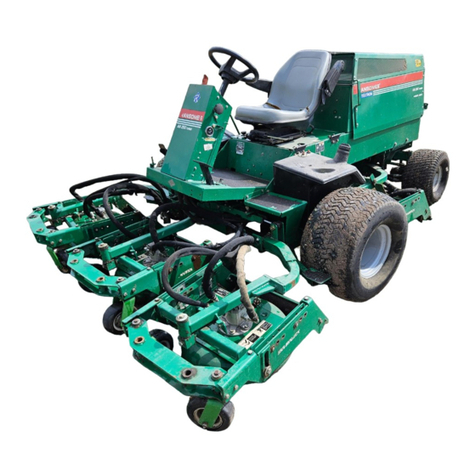
Textron
Textron RANSOMES VN Series Guide

Textron
Textron Steiner 425 Owner's manual

Textron
Textron Steiner 420 Owner's manual
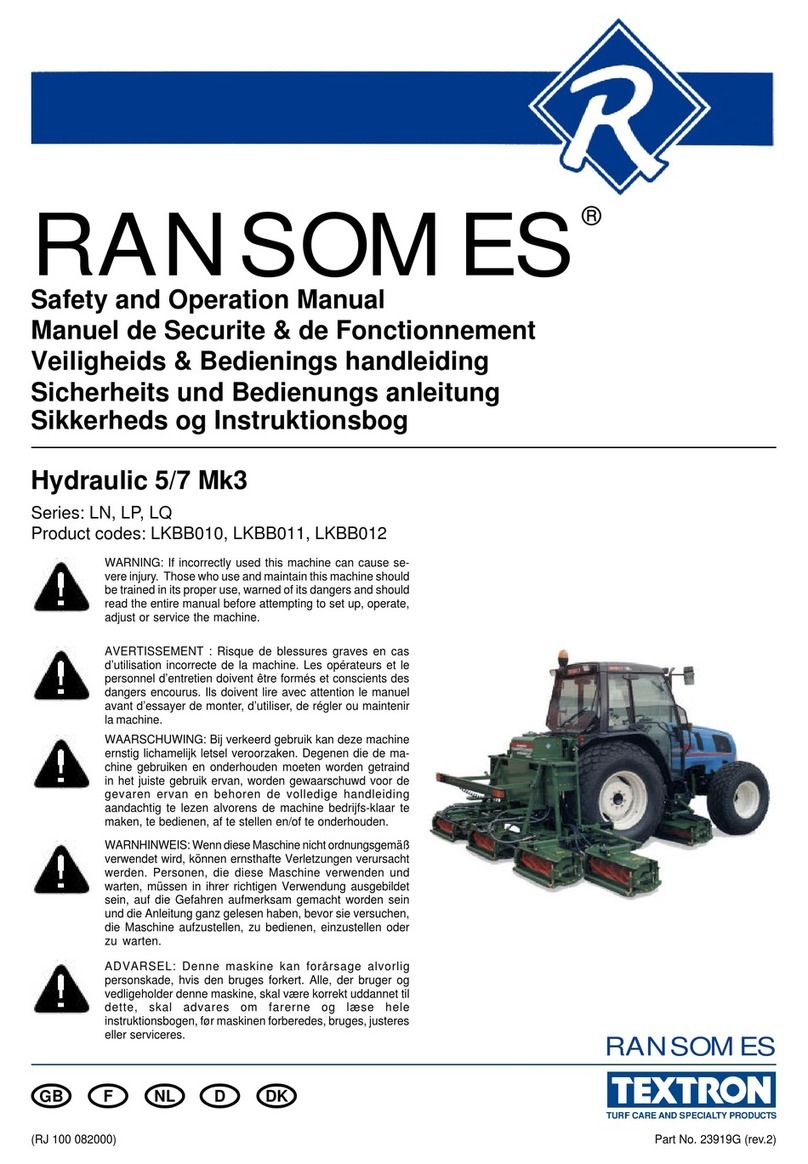
Textron
Textron RANSOMES LN Series Guide
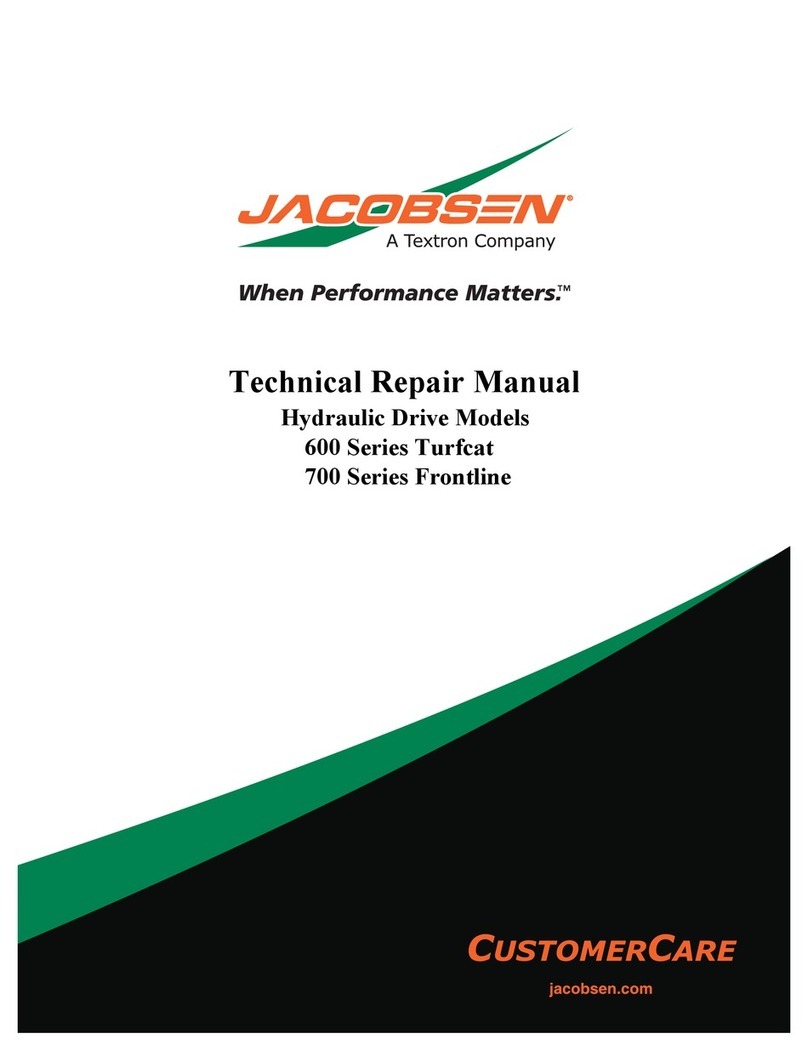
Textron
Textron Jacobsen Turfcat 600 Series Operating instructions
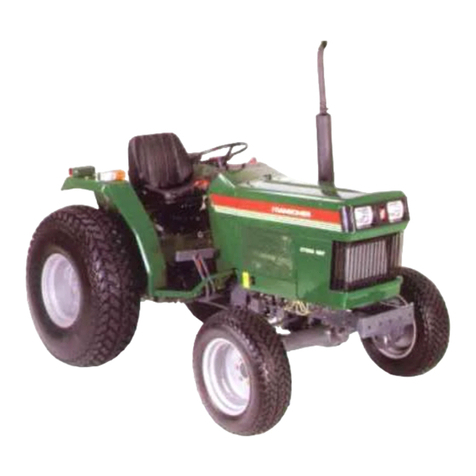
Textron
Textron Ransomes CT435 Specifications
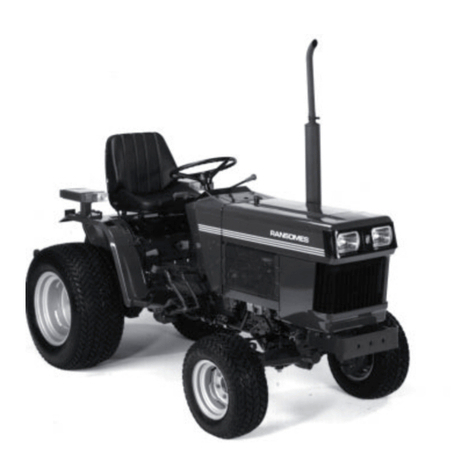
Textron
Textron Ransomes CT445 Specifications
